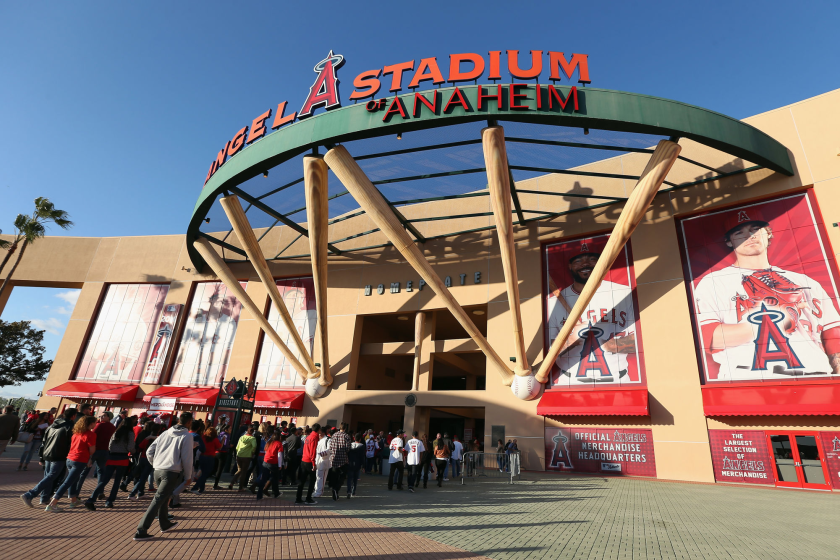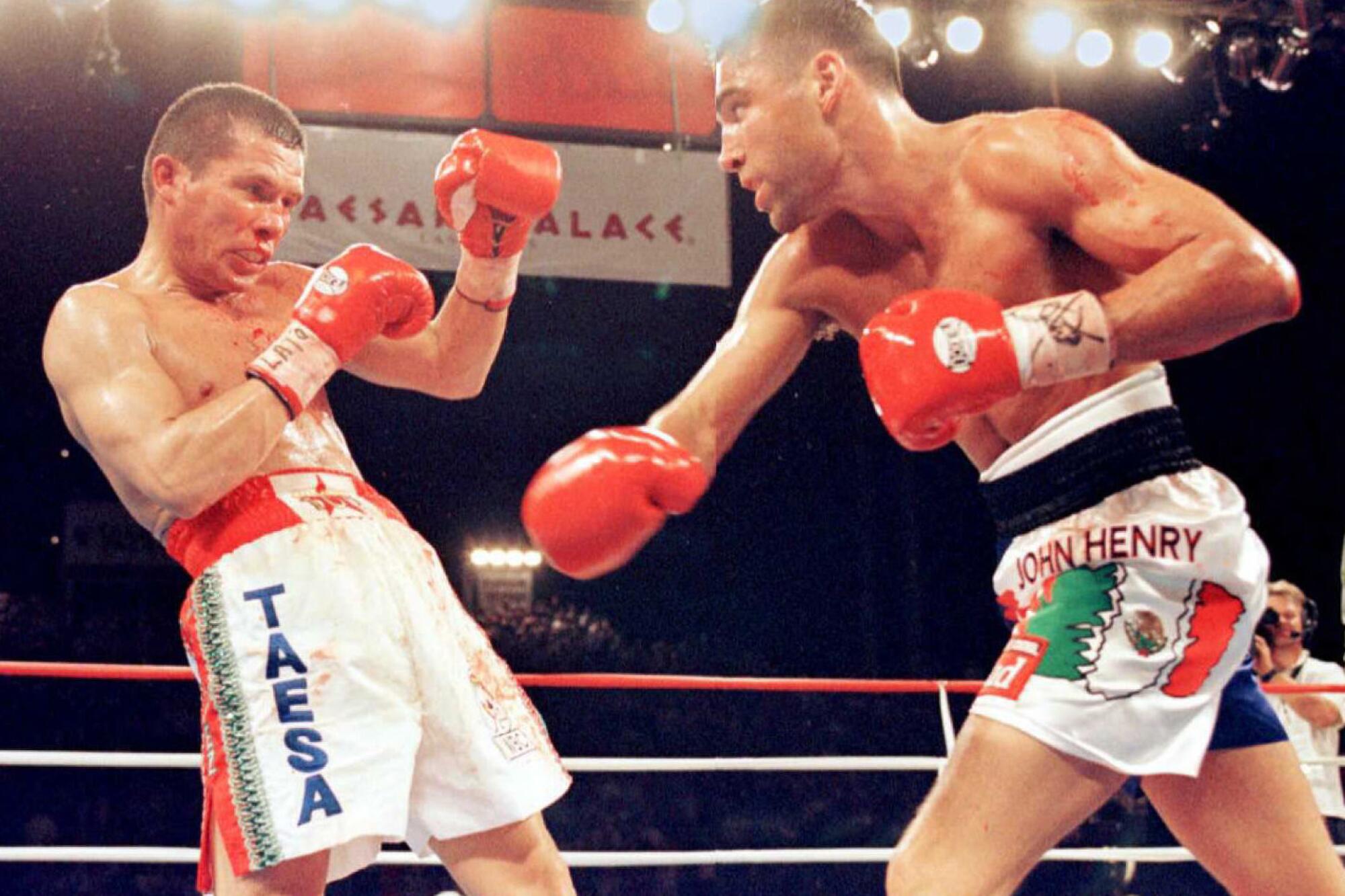
- Share via
On June 7, 1996, Julio César Chávez faced Oscar De La Hoya. Promoters called the fight “Ultimate Glory.” Held outside of Las Vegas’ Caesars Palace on a hot Friday night, the fight was, in many ways, a clash of opposites.
Chávez, 33, was a Mexican national hero entering the 100th professional fight of his career. De La Hoya, 23, was a once-in-a-generation Mexican American boxer about to enter his prime. But more than a fight between a once-great boxer versus another with expectations of greatness, Chávez versus De La Hoya symbolized something more in the United States’ Mexican community.
Chávez versus De La Hoya divided people, even families, splitting them along generational, gender and class divides.
The fight between Chávez and De La Hoya became a proxy for all the complexities that come from being of Mexican ethnicity, living in a place that was once Mexico. And when the fight began, 15,283 people gathered in Las Vegas. Across Mexico and the United States, hundreds of thousands more gathered to watch Chávez, a man some saw as a god, box against De La Hoya, a man who sought to escape from the Mexican’s shadow.
This is the story of that fight — 25 years ago — between a man who epitomized everything Mexican boxing was and a man who’d be criticized for not being Mexican enough.
::
Part 1: The Mexican boxing culture
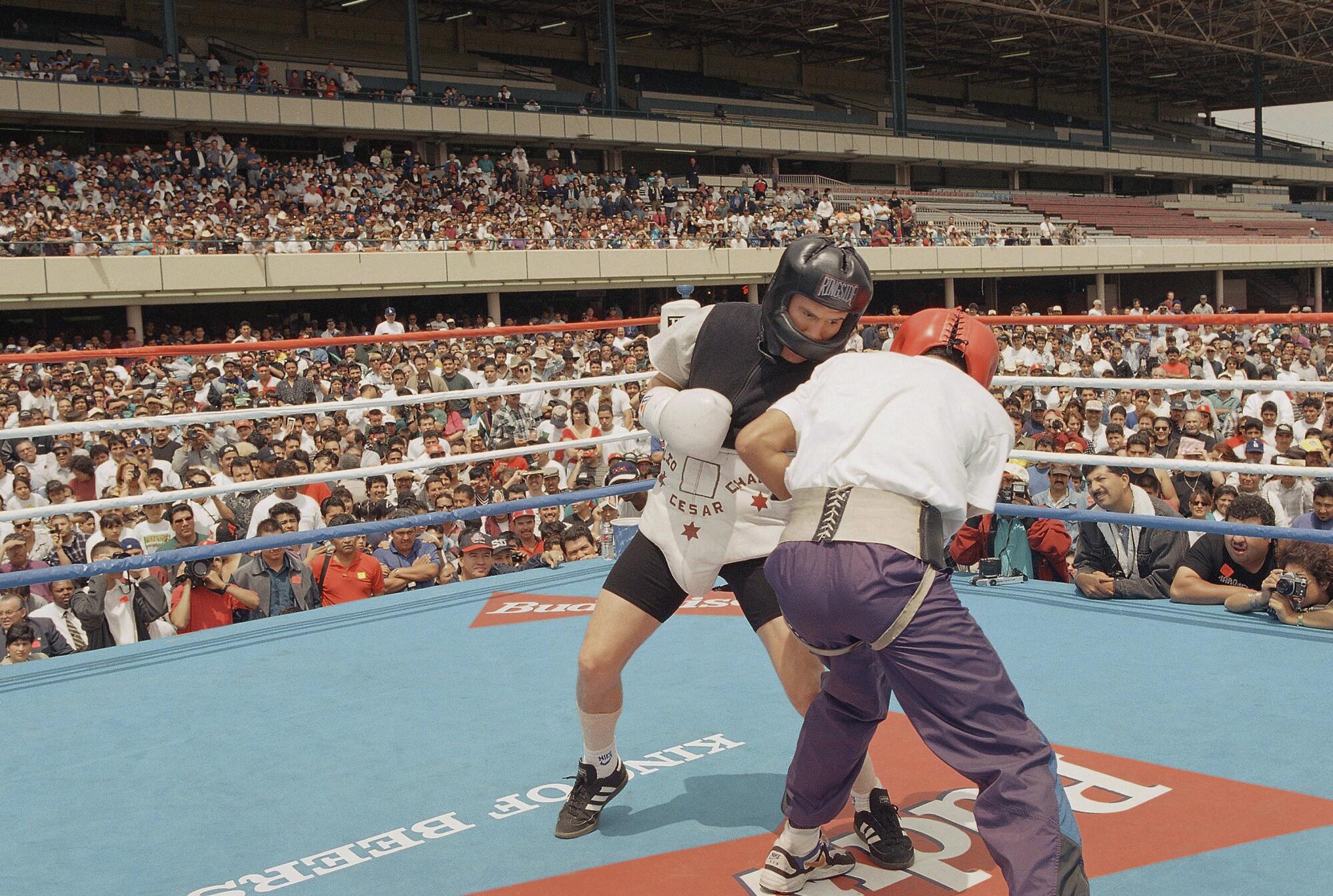
Eric Gomez, president of Golden Boy Promotions, childhood friend of Oscar De La Hoya: In Mexico, there’s a rich history of world champions. We’ve been fortunate enough to have some really big stars even way back in the ’40s and ’50s. It’s a passion. It’s a tradition.
Gene Aguilera, boxing author and East Los Angeles native: We would gather around the TV, have a party and watch boxing.
Fernando Paramo, former La Opinión sports editor: When we first came in the ’60s, they used to transmit Mexican boxing every week in Los Angeles. Televisa used to send the link over to KMEX. We saw the careers of people like Sal Sanchez, all those guys, anybody fighting in Mexico City, in Arena Coliseo and Arena Mexico — which was pretty much the temple of boxing in Mexico — they would show it here.
Joel De La Hoya Jr., Oscar’s older brother: Our father and grandfather fought professionally in Mexico. I remember watching fights on TV from Arena Coliseo in Mexico, religiously.
Paul Rodriguez, comedian and friend of Chávez and De La Hoya: There has always been a major Mexican boxing champion. I think that’s what sustains a lot of us. A lot of Mexicanos have a lot of pride in that.
“[Julio César] Chávez used to go a lot to the Vegas Hilton, and all the dealers were prohibited from speaking Spanish. ... After about six months, a year, they requested the dealers speak Spanish. ... He was the one that opened Vegas to the Spanish-speaking people.”
— Fernando Paramo, former La Opinión sports editor
Joe Cortez, referee for Chávez versus De La Hoya: The Mexican fans, when they see a fight, they are prepared to scream their lungs out and to get emotionally involved with the fight and with the fighters. You don’t see a better fight fan than a Mexican fight fan.
Ruben Espinoza, professor and director of Latinx and Latin American Studies at Chapman University: Boxing is that space where it’s one-on-one. “You’re going to insult me? Now let’s get in the ring and settle it with our fists.” You can’t separate why Mexicans love the sport from that context. The context of migration, of discrimination, even social movements like the Chicano movement that made you proud to be Mexican.
Rodriguez: We’re taught to fight back. It might not be socially acceptable, but I like that. I like the fact that we live difficult lives but we’re fighters. Life is a fight, sometimes difficult. That’s why we hold boxers in such esteem. Because it’s a metaphor for our lives.
::
Part 2: El Gran Campeón Mexicano
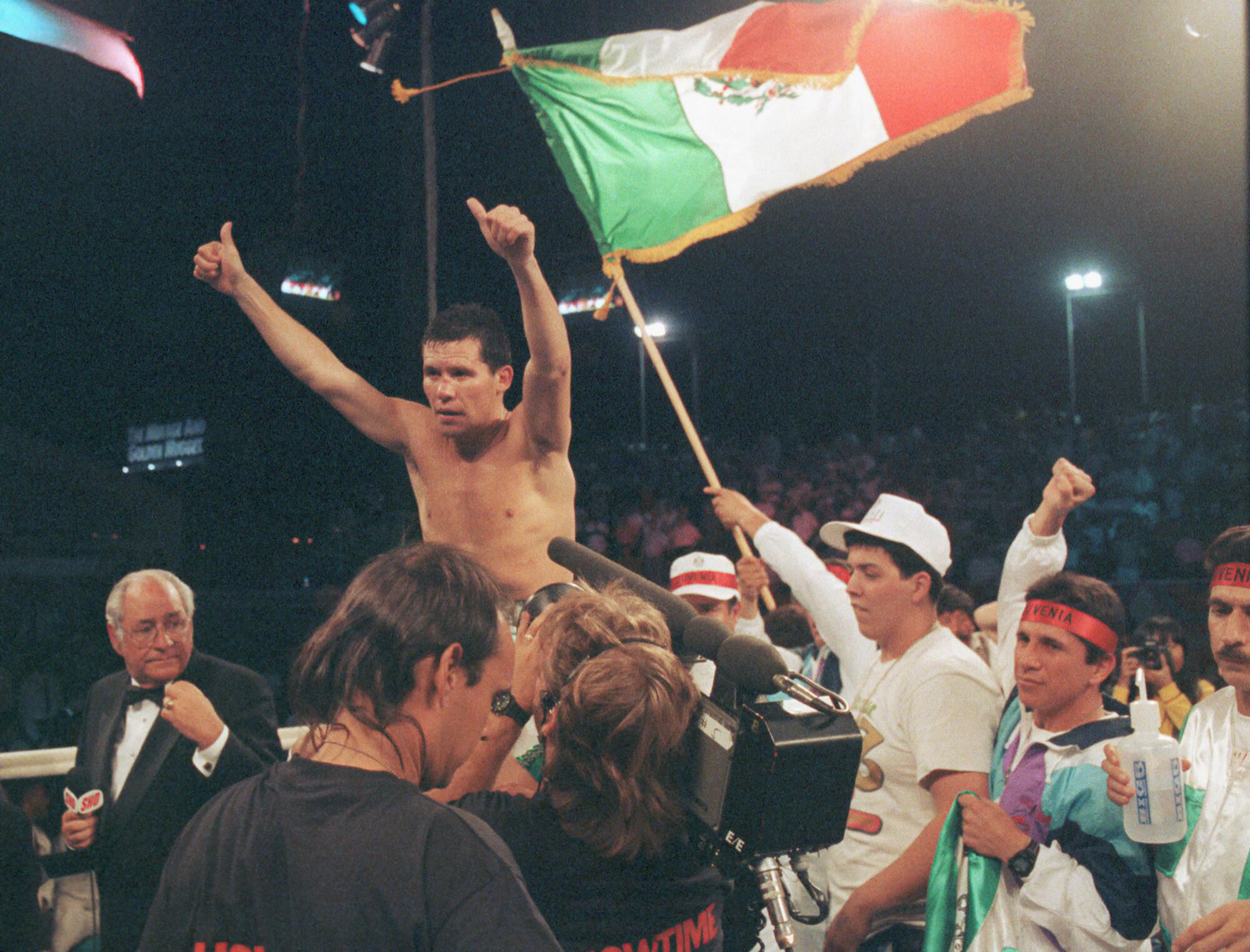
Chávez was a national hero to people of Mexican ethnicity on both sides of the United States-Mexico border. He’d fought his way from the obscurity that comes from fighting in the undercard of bouts in Mexico to becoming a main event attraction in the United States. Chávez built his career during the 1980s that U.S. news media and advertisers called the “Decade of the Hispanic.” He was Mexican machismo personified, the type of folk hero who inspired songs. Chávez was “El Gran Campeón Mexicano” — the great Mexican champion.
Rodriguez: Before Chávez, [his hometown of] Culiacán wasn’t known for anything. “Los hombres vienen de Guadalajara” [a Mexican saying: “Real men come from Guadalajara” — birthplace of charros, Mexican horsemen, who influenced Mexican masculinity]. But Chávez put Culiacán on the map for something other than drug trafficking.
Aguilera: I was at Olympic Auditorium when Julio fought Azabache Martínez for his first championship in 1984. Chávez was the underdog. It was a very unique night. Not too many people knew about Chávez. They were fighting for a vacant title, and Azabache was ranked No. 1 and Chávez was ranked No. 2. Chávez ended up just totally manhandling Azabache and turned him into a bloody mess by the end of the fight. I mean, he just totally overwhelmed him, controlled the fight. That night, a star was born with Julio César Chávez.
Cortez: Chávez had a reputation of one of the toughest fighters to beat.
Boxing: Vanquished former champion says that De La Hoya reopened a wound suffered in a sparring incident five days before the fight.
Larry Merchant, HBO Sports’ commentator during Chávez versus De La Hoya: Chávez was the epitome of the fierce Mexican warrior. He was tough-minded, he attacked the body. I think it’s fair to say he was primarily responsible for communicating the kind of warrior spirit that the top Mexican fighters had and that their fans expected.
Aguilera: Julio fought like a man. He fought like a warrior. He was macho. He was cocky. He had confidence and people loved that about him.
Espinoza: Mike Tyson was the first person that captured my imagination. And then Chávez after that in the early ’90s. He was pretty much like my deity, my god. I think a lot of Mexican and Mexican American kids will tell you the same.
Gomez: Chávez was a hero, a god. He was incredible.
Teresa Tapia, widow of Johnny Tapia, who fought on Chávez-De La Hoya undercard: Johnny, growing up, wanted to fight like Chávez.
Joel De La Hoya Jr.: He represented Mexican boxing at its best, he was the face of boxing. Like every Chávez fan, we’d have parties every time he fought. It was a time to get together with friends and family to watch one of the greatest boxers of all time.
Rodriguez: Chávez always kept an air of “soy puro Mexicano.” Hablaba muy común. No ponía aires. (“I am pure Mexican.” He spoke to the common man. He didn’t put on airs.)
Paramo: Chávez used to go a lot to the Vegas Hilton, and all the dealers were prohibited from speaking Spanish. Then Chávez started coming in with his buddies, a lot of the heavy guys from Mexico, coming in with big rolls of money, and started playing the tables, and the whole place is full.
After about six months, a year, they requested the dealers speak Spanish. Not just that, but all the guys — [Mexican singers] Juan Gabriel, Rocio Durcal — they were playing in the little bars, they weren’t playing at the big scenes. It wasn’t until Chávez came on that they started opening at Caesars for the big shows. Chávez should have a big statue right in Vegas because of what he did for the Mexican community. That’s something no one’s even thought about: that he was the one that opened Vegas to the Spanish-speaking people.
Rodriguez: The thing that Chávez had, that not even De La Hoya had, and very few people are able to possess, was a certain kind of earthiness. He had a certain kind of approachability. I remember going with him to eat in East Los Angeles, to this little hole-in-the-wall, and he was already a superstar, but everybody — from the cab driver to the guy mowing the lawn to the business owner — they felt they knew him. Like they could walk up to him and shake his hand and say a couple of words. He never lost that, even at the height of his fame when he would stop traffic.
::
Part 3: The Golden Boy
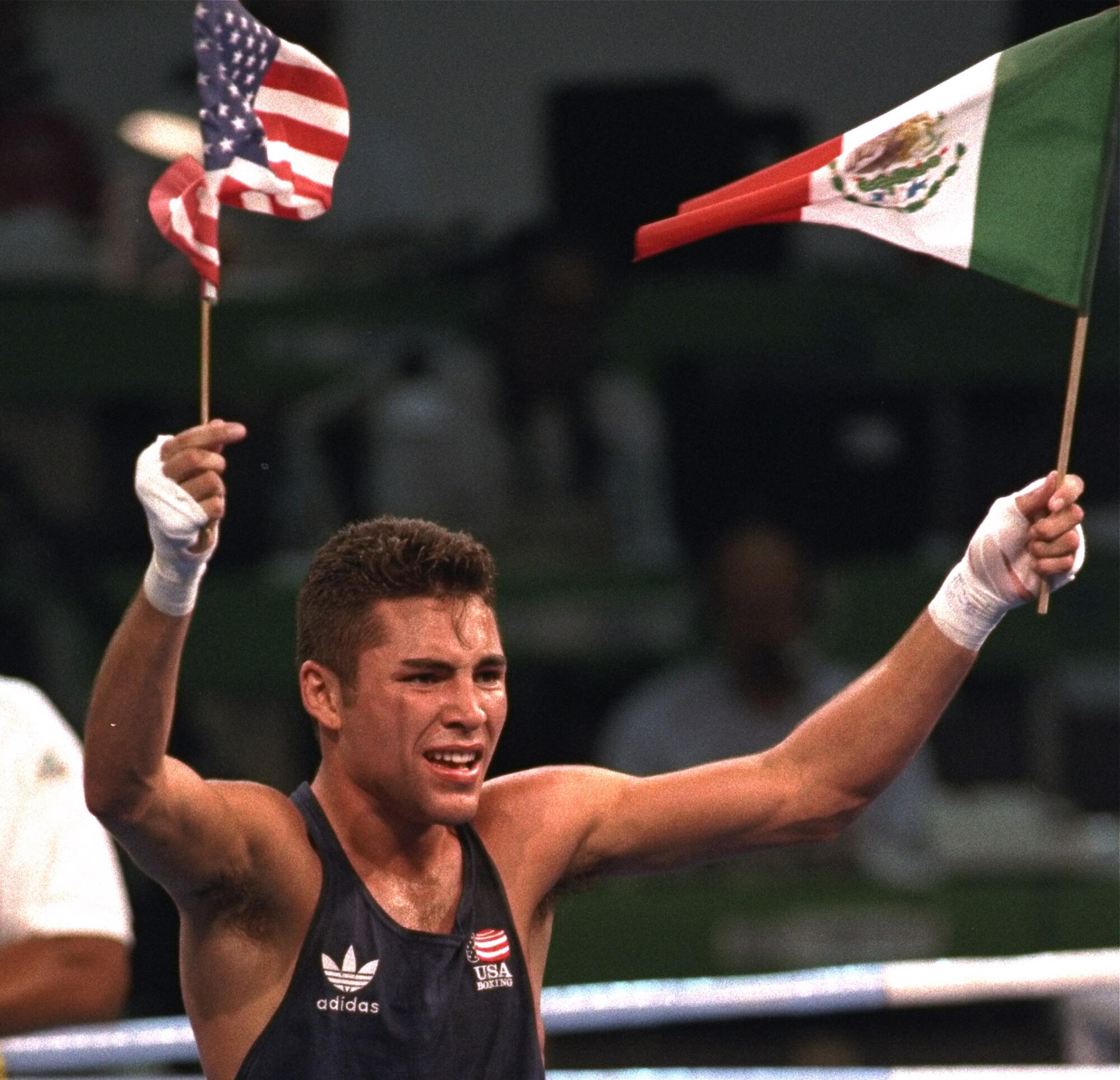
De La Hoya was Mexican American. The son of immigrants, he was born and raised in East Los Angeles. He was a bilingual Olympic gold medalist with movie-star good looks, a soft voice and a warm smile. As De La Hoya built his career in the 1990s, when the country’s Hispanic population boomed — with Mexicans accounting for most of the growth — he became the ideal corporate pitchman. De La Hoya idolized Chávez. In and out of the ring, in both nickname and in terms of mass appeal, De La Hoya was “The Golden Boy” of boxing.
Gomez: I’ve known Oscar since we were 5 years old. We met in kindergarten.
Oscar De La Hoya (in a 1996 interview with Playboy): I was a little kid who used to fight a lot in the street and get beat up. But I liked it. So my dad took me to the gym.
Aguilera: Boxing was very important to East L.A. It served as a vessel for the young kids to break out and become somebody. Using Oscar De La Hoya as an example, he grew up in a humble neighborhood, a small house, and he raised himself up.
Paramo: I first knew about De La Hoya when he was about 9 years old. We did a report on him from the Resurrection Gym. We used to have him regularly, not too much, I’d say until the Olympics. We had him featured once every two years.
Gomez: We were teenagers and he started winning these big tournaments. He started traveling a bit. I remember him talking about big tournaments that were coming up. He would let me know when he won. He kept talking about his dream of going to the Olympics. In high school, that’s when we knew it was real. That yeah, this guy’s got a good chance of making it to the Olympics.
Three days before Friday night’s World Boxing Council welterweight title fight at the Thomas & Mack Center, Oscar De La Hoya already had his game face on.
Aguilera: I met Oscar before he even went to Barcelona for the ’92 Olympics. He was looking for sponsorships. I was in the East L.A. Lions Club, and he came over and spoke to our club. We ended up giving him $500. He was very happy about it.
Rodriguez: I met Oscar De La Hoya before he went to the Olympics. I had a talk show [“El Show de Paul Rodriguez”] and he came on. I remember giving him $50 when he went to Barcelona. It was the best investment I ever made.
Gomez: He called me, like, three or four times when he was out there in Barcelona. He’d call me after pretty much every fight, and it was fun, it was exciting. The fights were coming on almost at midnight. I remember we stayed up to watch. Two of my brothers were with me. I remember Oscar was a little nervous in the fight. He was confident that he would win. He was prepared. He was ready. Just a proud moment for all of us.
Espinoza: I liked De La Hoya; a lot of my friends did not. I supported him since I heard about him in the Olympics. ESPN and all those places had stories about De La Hoya, the story about his mom passing away and him winning the gold medal for her.
Merchant: De La Hoya was almost a superstar when he became a professional prize fighter. At that stage of his career, he was already an important figure in boxing. He was a big attraction, and there aren’t many of those. There are great fighters that never became big attractions.
Albert Perez, Spanish language journalist who grew up in East Los Angeles: In school, in Montebello, right next to East L.A., you either knew somebody that had met Oscar, or knew somebody who knew somebody that knew Oscar. So I grew up around a lot of De La Hoya fans.
Aguilera: I went to most of De La Hoya’s fights — the ones in Vegas, New York. Because I’m from East L.A., he’s from East L.A., I was just proud of his ascent to greatness.
Mark Taffet, then-senior vice president of HBO Sports: Oscar had Hollywood star good looks. When we used to go on press tours for all his pay-per-view mega-fights, there would be as many, if not more, women in attendance than men. He had a rock star appeal. He was the first pay-per-view star where we specifically targeted marketing and advertising to the female audience.
Merchant: I was once in Spain with my wife. We were in a taxi, and hanging from the rearview mirror were a couple of little boxing gloves. And my wife says to the driver, “Who is your favorite fighter?” He says, “Oscar De La Hoya.” He was virtually an international star.
Merchant: One of the ironies is that when he was called a crossover star, they wanted to promote De La Hoya as somebody who crossed over from just being another very good Mexican or Mexican American fighter to trying to find his fanbase among Americans. But as it turned out, Mexicans felt — from as much as I could observe — that because of that plan, because of that background, and his look, and his confident American style, that somehow, he had abandoned the Mexican base. That’s important in understanding the Chávez fights with De La Hoya.
::
Part 4: The promotion
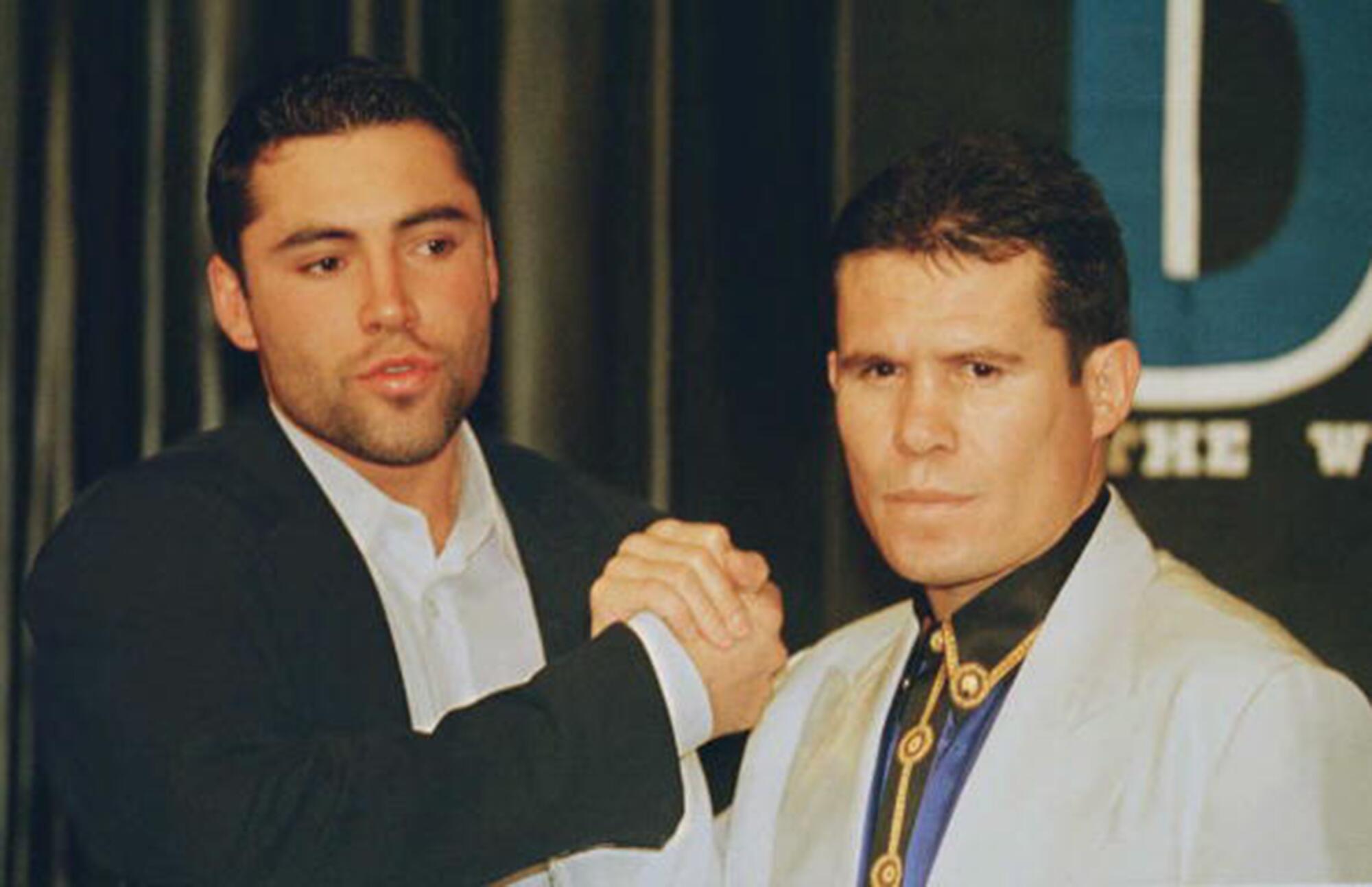
To help promote the fight, in March, Chávez, De La Hoya, and their respective teams went on a 23-city, 12-day tour. Caesars Palace supplied them each with a private jet that had “Ultimate Glory” and the boxer’s name on the side. Starting in California, then Arizona, New Mexico and Texas, the news conferences then went through East Coast states before circling back around to reach Washington and moving down the West Coast.
“The blood of the old Aztec warriors flows in the veins of these fighters,” Bob Arum, co-promoter along with Don King, said at more than one stop. And at more than one stop, including Los Angeles, the crowd booed De La Hoya. “Oscar De La Hoya lives among you,” the Los Angeles Times quoted Arum telling the crowd. “He is part of your culture in Los Angeles. You should be very proud of him.” The boos continued, while the crowd cheered for Chávez.
Taffet: It was a very difficult juxtaposition of the great Mexican-born legend and the great Mexican American who was leading the demographic change in the United States.
Yxta Maya Murray, novelist and law professor: It was old guard versus new guard. It also seemed to be wrapped up in some sort of anti-capitalist critique, because De La Hoya was marketing himself as a made commodity. He was promoting himself as a product for a white audience, whereas Chávez was for the people.
Oscar De La Hoya (in a 1996 interview with Sports Illustrated): People want to see blood and bruises, but I’m not going to give them that. I love boxing, but I hate fighting.
Julio César Chávez (in a 1993 interview with the New York Times Magazine): I hate boxers who dance. To me, that is a stinky style.
Paramo: Julio was almost on his way down, and Oscar was almost to the top.
Gomez: When the Chávez fight came, it really split people. It was weird. It was different. It was confusing. But for us, we were happy that he got his opportunity. Oscar wanted to prove he belonged.
Aguilera: When De La Hoya fought Chávez, it divided the people, it divided families. It was basically Mexican American — Chicanos — against Mexico.
Joel De La Hoya Jr.: Oscar got some backlash from the Mexican nationals for going up against their hero. Oscar wasn’t considered Mexican enough, although both our parents were born in Mexico — dad in Durango and mom in Sonora.
Aguilera: I was in the middle for this fight. I knew Oscar and I didn’t know Chávez — I met him a few times, but we weren’t friends. Because I’m from East L.A., he’s from East L.A., I guess my allegiance was for De La Hoya. I kind of knew he was going to win. He was a shooting star at that time, and Chávez was fading.
Tapia: Johnny had loyalty to both. He didn’t want them to fight.
Boxing: Everything seems to be on challenger’s side, but champion is not one to be discounted.
Gomez: Boxing is a solitary sport. It’s not a team sport, and potentially, you do fight friends and people that are from your stable. That’s just the nature of boxing.
Tapia:We were in camp with Oscar, training up in Big Bear with him. Oscar did a lot for Johnny. … I was rooting for Oscar only because I knew him more. I knew Chávez, and who wouldn’t be a Chávez fan? But I knew Oscar on a personal level. We were seeing Oscar every single day. As a matter of fact, it was Oscar that changed Johnny’s ring name. Johnny used to be called “Baby Face Assassin,” and Oscar called him “Mi Vida Loca” because Johnny was also crazy in camp.
Oscar was always very careful and had his stuff together. Johnny would show up with a broken finger, or a cut leg, or stitches on his face. Oscar, as soon as Johnny would walk in, he’d say, “Tapia, what happened?!” Johnny would say, “Oscar, I was over there, and I got into this fight.” Oscar would say, “Tapia, no! No!” He was always trying to lecture Johnny. So, after a few months of being with Oscar’s camp, he said, “You’re no longer ‘Baby Face Assassin,’ you’re ‘Mi Vida Loca.’” And Oscar went and got Johnny his very first endorsement with B.U.M. Equipment and surprised Johnny with trunks and a robe that said, “MI VIDA LOCA.” From that day on, the name stuck.
Rodriguez: I interviewed Chávez one time, and he said something I never forgot. I said, “Do you ever contemplate a loss?” It was like I said a filthy word. He totally changed and said, “No me menciones eso de perder, nada de eso.” (Don’t mention losing or any of that.) He was really offended, and it wasn’t a show. You could tell that it just never crossed his mind, which, in my mind, made this a very dangerous fight. Because someone like that can die in the ring.
Julio César Chávez (in a 1993 interview with Sports Illustrated): I could not bear the thought of losing, because it would hurt my family.
Cortez: This is not a game. You don’t play boxing. You play baseball, basketball, soccer. But boxing, you don’t play that. Boxing is the hurt business. They’re there to attack each other, to hurt each other.
Gomez: Oscar did everything perfect and by the book. For boxers — day in and day out, the training, the dieting, the sparring, the road work — just going to camp is tough. So, there’s days they’ll slack off. You got to rest the body. But for this fight, Oscar did everything textbook. Every workout, he didn’t skip a beat. It was laser focus.
Star boxers Oscar De La Hoya and Julio Cesar Chavez admit drug use
Rodriguez: Here was the Mexican American against the Mexican. And Mexicans always have a certain nostalgia for their country. They can never erase it. We’re here, we’re totally American, but you ask us, and we’ll say, “Yo soy de Sinaloa.” (I’m from Sinaloa.) If you have parents that were from there, they always had this nostalgia that someday they’ll make enough money, or be financially set, and they’ll return to their Mexico.
The truth is, we die here and get buried here. But we have an affinity to Mexico. We love Mexico even though Mexico doesn’t love us. And we know that because we’re treated different. But that’s part of the mystery of us. We have this undying loyalty and patriotism to a country that doesn’t want anything to do with us. It’s strange.
::
Part 5: The Fight
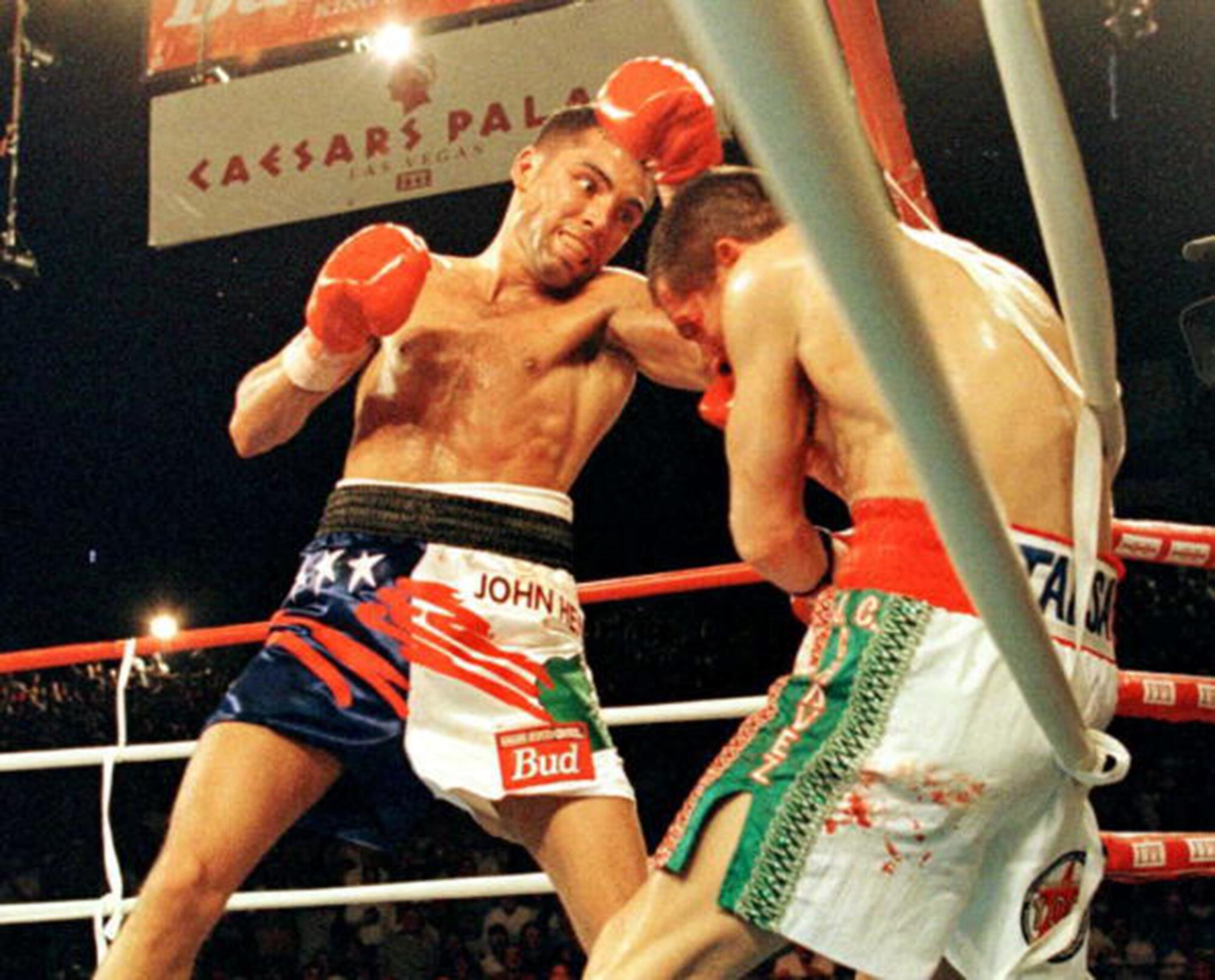
Chávez versus De La Hoya was not available on pay-per-view. “There have been estimates that for every home that buys a fight, two homes steal it,” Arum said of illegal black boxes in a March 1996 interview with the Los Angeles Times. Instead, the fight got broadcast on closed-circuit television at designated theaters, convention centers, casinos, fairgrounds, arenas and stadiums across the United States and Mexico.
Taffet: I worked during the entire promotion with Bob Arum. I spent a lot of time trying to convince him to put the fight on pay-per-view. I greatly understood and respected Bob’s point. But I also felt that at the end of the day, the revenue in closed-circuit would never approach the revenue on pay-per-view. And I knew that in pay-per-view, we needed time to market and promote the event properly and to get all the information to the cable and satellite systems so they could make their customers aware. It became a real battle, and a nerve-racking one, as it got closer and closer to the event.
Even as close as a week before the fight, I was still negotiating with the pay-per-view industry to try to enhance the terms. But in the end, Bob stood his ground and made a point. It was the last time that a big pay-per-view fight was ever on closed-circuit.
“It was one of the most electric nights ever in boxing. You had the passion of Latino fight fans, there to watch their legend, Julio César Chávez, against the up-and-coming star who was not only Latino but also had tremendous appeal to a young American audience.”
— Mark Taffet, then-senior vice president of HBO Sports
Perez: I saw it at the Rose Bowl. I got those tickets, that same morning, from an oldies radio station. It was $40, it wasn’t cheap. If I hadn’t have gotten those tickets, I probably would not have gone.
Murray: I watched at the L.A. Memorial Sports Arena.
Gomez: I watched at East L.A. College. They opened the auditorium and showed it there. It was probably 80% Chávez fans and 20% Oscar fans.
Taffet: It was one of the most electric nights ever in boxing. You had the passion of Latino fight fans, there to watch their legend, Julio César Chávez, against the up-and-coming star who was not only Latino but also had tremendous appeal to a young American audience and to females in a way that no boxing star had before him.
Dr. Edwin “Flip” Homansky, chief ringside physician for Chávez versus De La Hoya: It wasn’t part of my job, but I did see it. I felt it. There’s no question in my mind De La Hoya felt it. And I think that psyched him up even more. De La Hoya knew the crowd — and this is even before fight night — at Caesars. They were a pro-Mexican, pro-Chávez group.
Cortez: I believe it was 98 degrees ringside. It was hot. I’ve refereed fights with that type of heat, and I knew it was going to be tough for everybody.
Homansky: It was hotter than normal. What people forget is beside the desert heat, the lights in the ring — the television lights — are hot themselves. This was a hotter-than-normal night. You combine that with the heat of the ring, and it was pretty brutal.
Taffet: The events were done to maximize revenues, not to maximize the comfort of the attendees. We knew going in it was going to be a very, very hot Las Vegas night. And actually, in people’s minds, it became part of the magic of the event.
It wasn’t a fight, it was an execution. As one-sided as an electric chair.
Tapia: It was very hot. Johnny actually fainted after his fight, and some fans had to help me carry him back to the dressing room.
Homansky: Chávez was always supremely confident, and he was just as confident going into this fight. De La Hoya understood the cultural impact. He was a little on edge.
Tapia: Johnny went to Oscar’s dressing room to tell him good luck and stuff. Oscar was very quiet, had soft music, and it was dark.
Oscar De La Hoya (in a 1996 interview with the New York Times): Chávez was in the best shape of his life. I had to keep my composure. I had to keep cool.
Cortez: Being inside that ring, listening to the national anthems, watching these fighters moving around, looking at them, I could see everybody was tense as they waited for the first bell to sound.
Gomez: Fight starts. From the get-go, Oscar’s on. I mean, he’s sharp. He’s peppering him with the jab and taking control with the speed, the combinations. Chávez didn’t even land a punch. He couldn’t touch Oscar.
Aguilera: Bam! De La Hoya pops him with a jab.
Joel De La Hoya Jr.: I saw blood trickling from Chávez’s eye.
Aguilera: It opens up, and Chávez is bleeding like a pig.
Boxing: Challenger, 36, puts up strong fight against De La Hoya before quitting in his corner after eighth round.
Homansky: I was focused on the cut and his eye. But because Chávez was such a veteran, I wasn’t worried about that. He wasn’t a young fighter, so I wasn’t worried what the cut would do psychologically. But obviously, the physical effects of the cut had to be watched.
Cortez: De La Hoya, when he saw blood, he went after it. Like, “Oh, I got him now. I got him.” He became more aggressive. He went for the kill.
Oscar De La Hoya (in a 1996 interview with the Washington Post): I knew when I cut his eye and broke his nose — I think I felt his nose break — I knew I had him.
Paramo: Three weeks before, I went to see Julio when he was training up in Reno. He had a great camp, one of the best ever. The week before, over at Hollywood Park, they had a press conference and supposedly — I wasn’t there because I wasn’t with them 24/7 — one of the kids, Junior, is jumping back and forth. He throws his head back and cuts Julio in the brow. I didn’t see it, but everybody talked about it. “He’s cut! He’s cut! I don’t know if he’s going to fight, he’s cut!” It was like a secret, but everybody was talking about it.
The day of the fight, I was about a foot and a half away from his face. I tried to look closely, and I really couldn’t tell anything. They said they put makeup on the cut, but I honestly could swear to God that I did not see anything out of the ordinary. … You could just see the normal wear and tear of any boxer.
Then he gets hit and cut. I said, “Oh yeah, it was real. The cut was real.”
Julio César Chávez (in a 1996 interview with Sports Illustrated): I never felt Oscar’s punch. I just was not able to see.
Gomez: Oscar just landed a jab. If you followed Chávez’s career, he rarely bled. He was known for being able to take a punch. And for Oscar to just land a couple of jabs and do that, I believe there might have been prior injury or something. How it happened, I don’t know.
Aguilera: He should have canceled the fight. But again, there’s millions of dollars on it so Chávez wanted to go through with it.
Taffet: Chávez is a warrior. He wouldn’t let anything stop him from getting in the ring to fight Oscar De La Hoya, to stand up for his people, his country. His pride wouldn’t allow him to do anything but get in the ring. That’s why Chávez was adored by his fans.
Julio César Chávez (in 1996 interview with the Los Angeles Times): I didn’t consider not fighting. It was too big of a fight.
Homansky: There was no evidence of an earlier laceration. I’m not saying there wasn’t a cut during training, that’s really not that unusual for a boxer. But I can tell you, a stiff jab from De La Hoya really opened a small laceration, and then a devastating right hand in that first round is really what opened up this cut. I can’t really say if there was an earlier laceration or there wasn’t, but I know that Chávez says there was. Whether there was or there wasn’t, it was De La Hoya’s punch that opened the cut.
“I could hear [Julio César] Chávez in his corner. He was screaming, ‘¡ESTÁ BIEN! ESTÁ BIEN! ÉCHAME LA POMADA! ESTOY BIEN!’ (‘It’s fine! It’s fine! Put on the ointment! I’m fine!’) It was his heart, of course. They let him go on for another couple of rounds. But it just got worse. It wouldn’t stop bleeding.”
— Paul Rodriguez, comedian and friend of Julio César Chávez and Oscar de la Hoya
Tapia: Johnny would say that Oscar had a deadly jab. When he would train, and you’d just watch Oscar and the way that he worked, how he hit the mitts, the sparring and all that — the cut was not surprising. Oscar’s punches were so sharp and precise.
Joel De La Hoya Jr.: If there was a cut prior to fight or not, it doesn’t matter. Oscar busted him open and imposed his will on Chávez. He was not getting denied that night.
Taffet: I knew that Julio César Chávez was a great, great fighter. And I knew that he was going to give Oscar a heck of a battle. The cut changed the complexion of the entire fight. That was the first moment, when I saw the cut, when I really started to believe, “OK, this night is going to end up Oscar’s night.”
Prior to that, I was very nervous because I knew that Oscar De La Hoya could carry the entire pay-per-view industry on his back if he won the fight. From a business perspective, there was a lot on the line for the future.
Rodriguez: I could hear Chávez in his corner. He was screaming, “¡ESTÁ BIEN! ESTÁ BIEN! ÉCHAME LA POMADA! ESTOY BIEN!” (It’s fine! It’s fine! Put on the ointment! I’m fine!)
It was his heart, of course. They let him go on for another couple of rounds. But it just got worse. It wouldn’t stop bleeding.
::
Part 6: The end
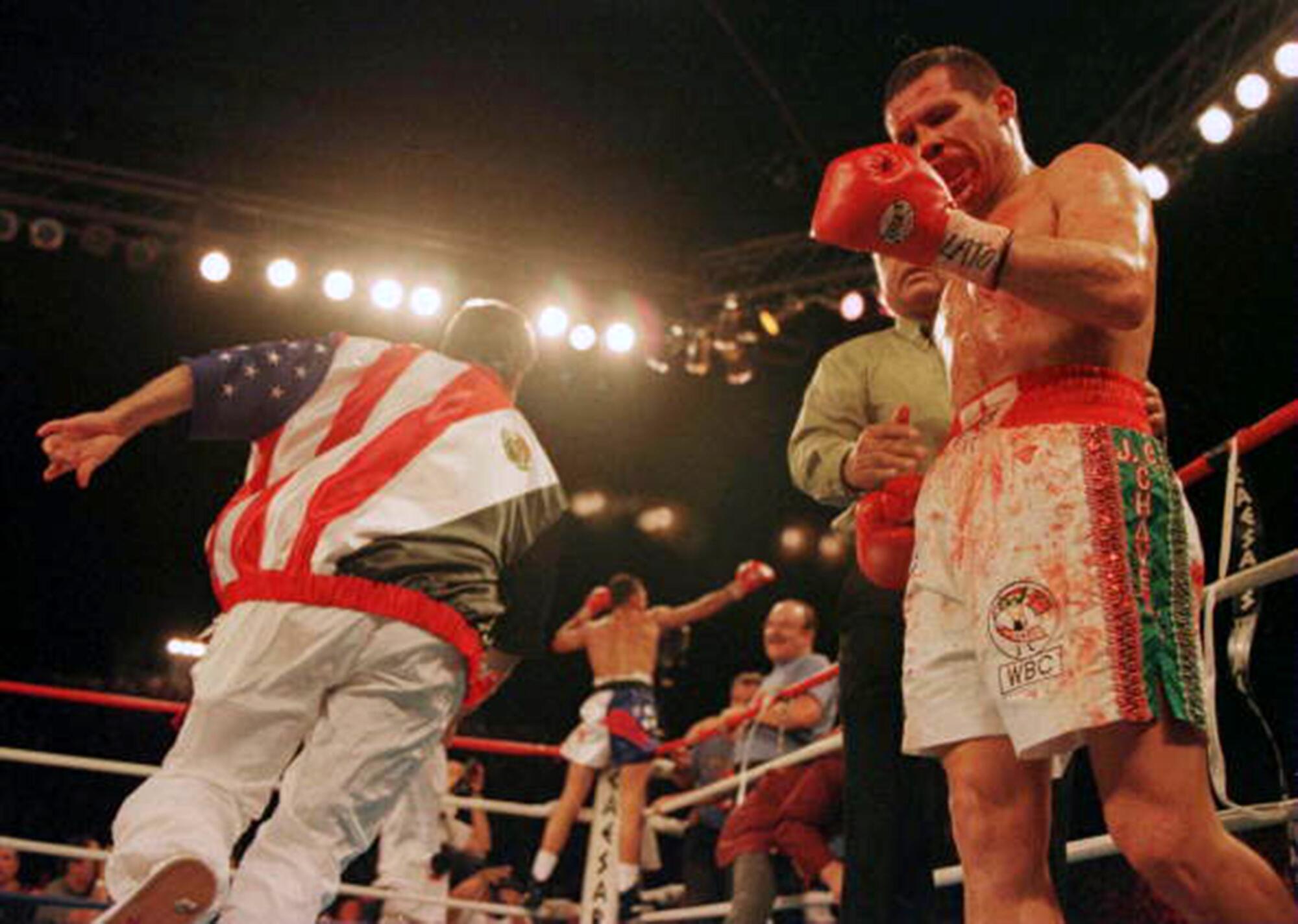
With about 30 seconds remaining in the fourth round, Cortez asked for a timeout. He asked Homansky to examine the cut. Chávez, his face covered in blood, his white mouthpiece and white trunks stained with red, walked to the ring doctor. Homansky stopped the fight. De La Hoya won. Until that fight, no one had ever stopped Chávez.
Homansky: Mentally, he appeared to be a beaten fighter. His eyes were down, his posture — I noticed those things. At the same time, my main focus was on how dangerous the cut was. The cut was above the eye. It was a nasty gash, and it was bleeding profusely. The blood was coming down into the eye, not just around the eye. In addition to that, early in the fourth round, De La Hoya had landed a brutal punch right to Chávez’s nose. So his nose was bloodied too. There was a number of different things going on at the same time.
Cortez: It was at least three inches. You see that blood coming out, you think to yourself, “The cut must be down to the bone.” I hated to stop a fight like this, but I was prepared for it. One thing people have to remember, a referee has to be prepared for the unexpected. Me, as a veteran referee, I was ready for it. I was shocked, but I was prepared for it.
Gomez: When they called it off, people were very upset. They didn’t understand it.
Murray: Chávez fans were melancholy. They shrugged when I asked them questions. They just wanted to get in their cars and go home.
Espinoza: The way a lot of people rationalized the Chávez loss — and probably myself, too — was that he didn’t actually get knocked out. That it was just a freak cut he suffered from that jab in the first round. A lot of people took comfort in knowing that he wasn’t knocked out.
Perez: They just couldn’t accept the fact it wasn’t Chávez’s night. You always got this at the time: “No, pues se vendió” [No, he took a dive]. That was the only explanation they had. It wasn’t because he was older. It wasn’t because De La Hoya was an electrifying young fighter. It was because Chávez sold himself out.
Joel De La Hoya Jr.: During camp, we knew it’d be a matter of time before Oscar would stop Chávez. We just didn’t expect total domination. It was one of Oscar’s stellar performances.
Gomez: Oscar was just super happy. And it was historic. It was almost like winning the gold medal. It was like a dream that’s not attainable, but Oscar pulled it off.
Homansky: I think there was a lot of vindication with De La Hoya. With Chávez, the fear was not only was this a major loss but that this was the beginning of the end of his career.
“[Julio César] Chávez said there’d be no excuses. And he said whoever wins takes the ultimate glory. And then here he is making excuses about this eye thing.”
— Oscar De La Hoya in a 1996 interview with the New York Times
Paramo: I interview Chávez. And he says, “Oh, well, the cut. I could have taken him.” But by then, it didn’t matter.
Rodriguez: I talked to Chávez first. De La Hoya was unapproachable. De La Hoya was mobbed, and his attention was on girls and all the hangers-on that fame brings you. Chávez received me, but it was very sad. “Campeón, tu sabes, qué lástima.” [Champ, you know, I’m very sorry.”] And he’s like, “No, pa’ la otra” [No, next time]. But there shouldn’t have been a next time.
Too much heart, too much courage is sometimes not a good thing. And of course, you have trainers and people around you that fuel that ego, telling you he got lucky. But there was nothing lucky. De La Hoya at the time was chiseled, cut, fast. He was as good as he was ever going to be.
Julio César Chávez (in a 1996 interview with Sports Illustrated): If Oscar had knocked me down, I’d have retired last night. But he was lucky, and this doesn’t mean he’s better than me.
Oscar De La Hoya (in a 1996 interview with the New York Times): Chávez said there’d be no excuses. And he said whoever wins takes the ultimate glory. And then here he is making excuses about this eye thing.
Espinoza: I don’t remember that much criticism of De La Hoya taking the fight until after he won. I don’t remember in the lead-up, many people saying, “He shouldn’t do that because Chávez is old.” That’s something that happened after. That’s when I started hearing from friends saying, “That’s disrespectful, he shouldn’t have done that. De La Hoya shouldn’t have taken the fight.”
Merchant: At 33 and 34 and 35 years old, it’s harder to be that immovable warrior.
Rodriguez: I have great respect for De La Hoya, he’s a nice guy, he’s never been anything but a friend to me, but that fight in particular was a turning point in his career. People went, “Hey, man, you shouldn’t have done that.” Of course, you can’t blame him. Once in the ring, fighting for millions of dollars, this is a career. You’re out there to hurt somebody if you have to. But it wasn’t a high point. It was a low point, I think.
Taffet: It really did establish Oscar De La Hoya as the next great pay-per-view star. It fueled the growth of Latino participation and viewing in pay-per-view events for the next 10 to 15 years. 1997 was a record year for Oscar De La Hoya. He had four pay-per-view fights. That all came about because [of] the big victory over Chávez in 1996.
Rodriguez: De La Hoya mistakenly thought that by beating Chávez, that all of a sudden, he would take over. That he would be the icon. He realized it was quite the opposite. He had to make a lot of amends. He had to backtrack and say, “No, no, él sigue siendo campeón, un ídolo” [No, no, he remains a champion, an idol], that sort of thing.
He was convinced, like, “once they know that I’m the champion.” I said, “Your history is wrong. Look what they did to Larry Holmes. He was a great fighter, but he was never beloved because he beat up Ali.”
“To my mind — as a writer, a sportswriter, a Mexican, a follower of boxing, whatever — that was the night Julio pretty much gave the flag to Oscar. There was no way he’d ever beat him again.”
— Fernando Paramo, former La Opinión sports editor
Paramo: When he fought Julio, De La Hoya took away the biggest thing Mexico had. And I think Oscar handled it well. He was very respectful. He’d say, “I’m Mexican and Mexican American.” I think eventually people respected him. Most people respect him. Some can’t stand him, but that’s because of his other personal matters and also because of his association with Canelo [Álvarez]. But I think De La Hoya was treated normally.
Perez: Chávez had set the expectations so high that people were not ready to see the downside of his career.
Aguilera: We’re a very loyal group of people, and when we get a hero, we follow him to the very end. To the end of his career, even when he’s on ashes, running on fumes, we still love our heroes. And that’s what happened with Chávez.
Paramo: To my mind — as a writer, a sportswriter, a Mexican, a follower of boxing, whatever — that was the night Julio pretty much gave the flag to Oscar. There was no way he’d ever beat him again. He was at the stage of his career that he could no longer come back and train for anything more. His body didn’t have anything else to give.
Rodriguez: I knew Julio had passed his prime. But I didn’t know that it would be so sad. That it would be so bloody.
Merchant: I didn’t expect to see a stoppage. I mean, my goodness, how do you stop Chávez?
Rodriguez: That was an iconic fight. Every once in a while, I would watch it on YouTube. I just can’t see it all.
Taffet: That fight really exemplified the social trends at the time. It was a very special night in boxing history. Not only because of the event and the participants and their greatness, but because it so clearly depicted the changing demographics in the Latino community and in the United States.
::
Part 7: The aftermath
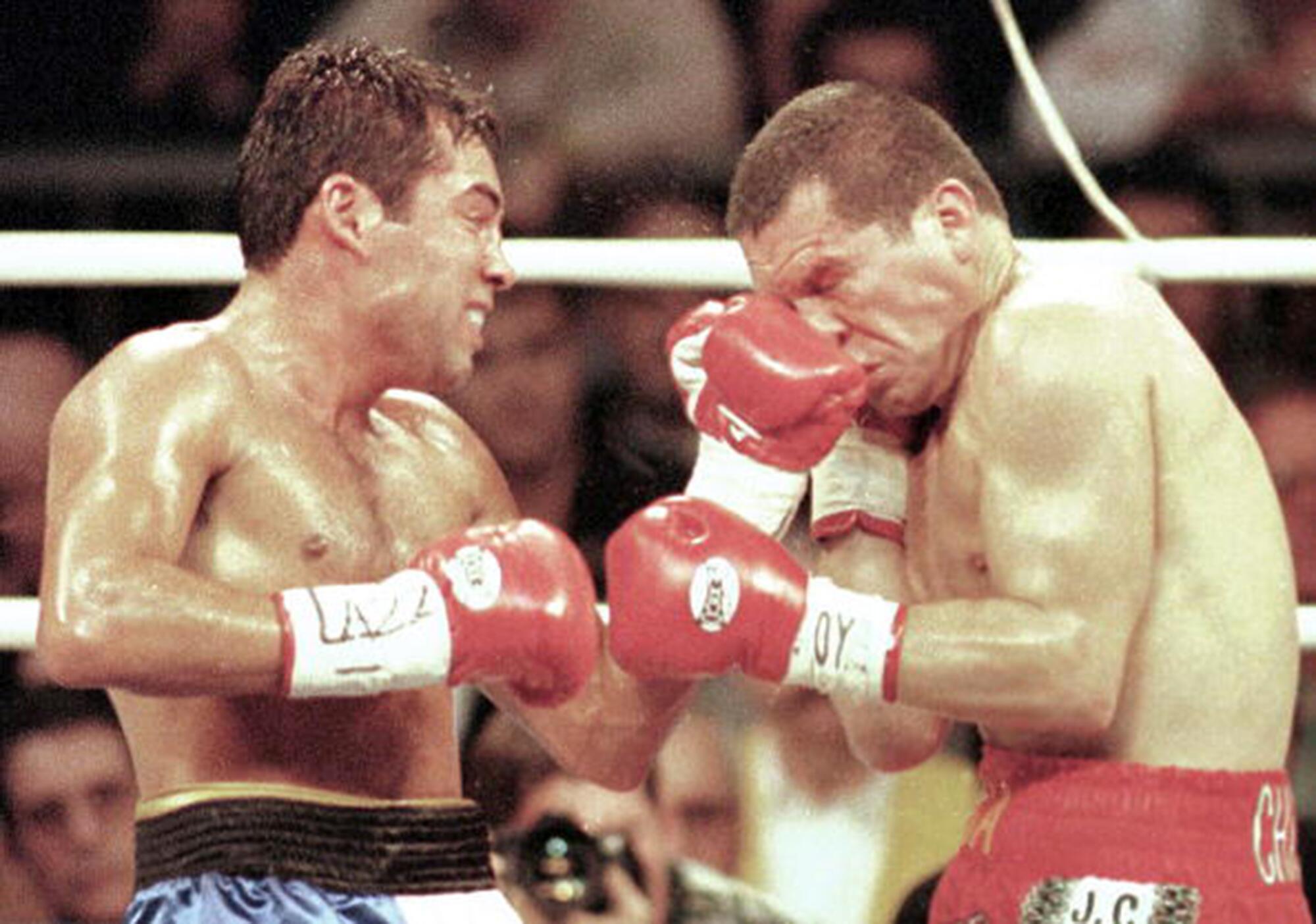
Before the fight, Chávez claimed he would retire after fighting De La Hoya. But Chávez kept fighting. Two years later, Chávez and De La Hoya faced off in a rematch. The fight was on Mexican Independence Day weekend, one of the two biggest boxing days each year that Chávez and De La Hoya both helped popularize. They fought at Las Vegas’ Thomas & Mack Center in front of 17,125 people.
Chávez, 36, showed flashes of his former greatness but not nearly enough to beat the 25-year-old De La Hoya. In the ninth round, with a cut inside their fighter’s mouth, Chávez’s corner stopped the fight. Chávez said he respected De La Hoya, that he had fairly beaten him. He then said he’d fight once more, then retire.
Chávez fought until 2005. De La Hoya, who had claimed he’d retire at 26, fought until he was 35. Chávez, 58, will fight in an exhibition June 19. De La Hoya, 48, plans to fight again soon.
Rodriguez: Comedians can tell jokes until they’re dead. But boxing, you’re like a butterfly. You have a certain amount of time when you’re in your prime. The intelligent ones know when it’s time to step away or it’ll shorten their lives. The worst are pushed by bad management and greed. They become just tragic stories like so many that died young. Those punches that they take, they have repercussions. It’s a heavy price they pay for a few moments of glory.
Interviews edited and condensed for clarity.
Roberto José Andrade Franco is an author, freelance journalist and writer-at-large for Texas Highways.
More to Read
Go beyond the scoreboard
Get the latest on L.A.'s teams in the daily Sports Report newsletter.
You may occasionally receive promotional content from the Los Angeles Times.







